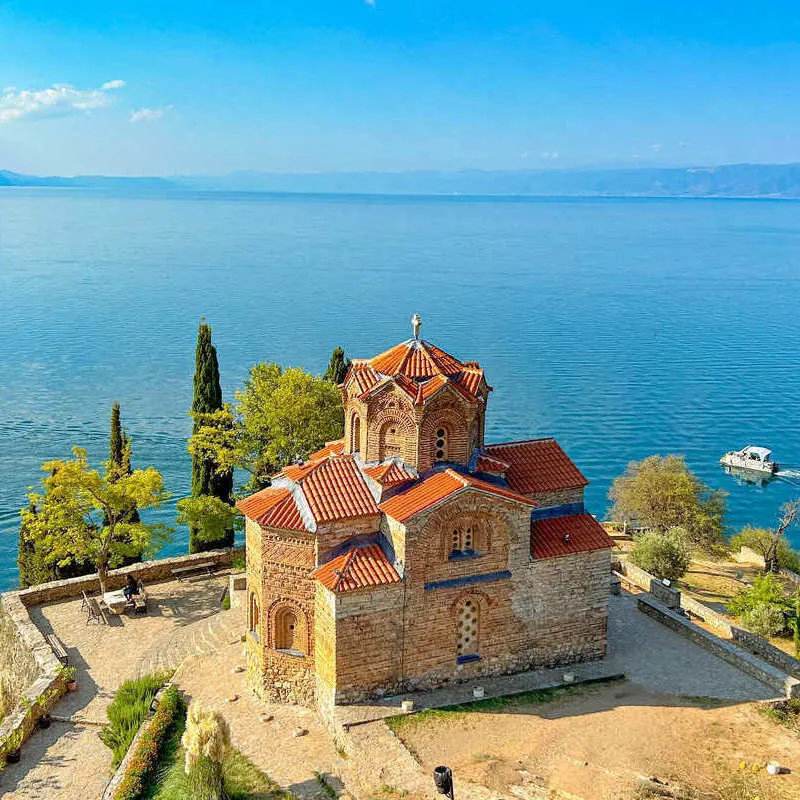It’s no longer news at this point that Europe will start fingerprinting Americans and charge them for authorization to travel.
Just this week, the European Commission confirmed that, from October 12, the new biometric scans will start, so if you’re heading across the pond this fall, be prepared to take off your gloves. On top of that, from late 2026, a $21 entry fee will be rolled out.
Based on your response, we could gauge that a majority isn’t thrilled about the prospect of stricter border rules and reinforced screening. Sadly, there’s just no way around it, at least when it comes to visiting the 29 European countries that have agreed to the new measures.
Luckily for those among us who are wary of over-reaching regulations, there are 12 European nations that will not be enforcing entry permits on Americans, nor storing their biometric information:
Ireland

The first such example is Ireland: unlike the United Kingdom, which has been requiring all Americans to get an Electronic Travel Authorization as of January 2025, Ireland has outright refused introducing digital entry permits so far.
In fact, the Irish administration was staunchly opposed to Britain’s own ETA, given the unique status of Northern Ireland, a part of the United Kingdom that shares an open border with the Republic of Ireland.
In their view, the different entry requirements when there’s no hard border in sight would be confusing for travelers, and they’re not wrong. While an ETA is mandatory for Americans visiting Northern Ireland (and other parts of the U.K.), in the south of Ireland, a valid passport suffices.
Serbia

A small nation in Southeastern Europe, Serbia has been growing rapidly in popularity with Americans due to its lower rates of violence, and relatively low levels of irregular migration compared to much of the crime-stricken West.
Needless to say, this has helped beautiful cities like Belgrade and Novi Sad socially-cohesive, clean, and safe for tourists.
On top of that, Serbia is not part of the European Union, nor the Schengen Zone, thus, they are not expected to adopt the group’s digital entry permit once it launches. Americans will continue being welcomed in Serbia with open arms, with their passports only.
There is a single rule in place, and it’s quite simple: you can’t stay longer than 90 days at a time.
Montenegro

A coastal nation bordering the Adriatic, Montenegro is the new ‘Croatia’.
While Croatia has fully swung West, and fit into the EU’s mold, however, its smaller, less-famous sister is neither in the European Union, nor the Schengen Area.
Americans are welcome to stay in Montenegro for 90 days without a visa, simply by presenting a valid passport with enough months of validity left, and enough blank pages to be stamped—check the exact travel rules with our new Entry Requirement Checker.
This means you can explore Montenegro’s gorgeous coastal towns, that typically date back centuries, beautiful turquoise bays, and lush mountainous inland without worrying about additional checks.
Bosnia and Herzegovina

Montenegro’s neighboring nation, Bosnia and Herzegovina is primarily known for its vibrant capital city, Sarajevo, where World War I infamously started, and historic riverside town of Mostar, home to one of Europe’s most iconic historic bridges.
Yep, the same one you see on the feature image above. Stunning, right?
Fortunately for the bureaucracy-wary travelers, Bosnia and Herzegovina is open to American visitors with little to no restrictions: similarly to Montenegro and Serbia, as long as you present a valid biometric passport, and you’re not staying longer than 90 days, you’re good to go!
North Macedonia

It seems it’s the lesser-known European nations that are on the Americans’ side, after all: up next, we have North Macedonia, a landlocked Balkan state characterized by its quaint medieval villages, unspoiled green scenery, and crystal-clear lakes.
Besides Skopje, the deliciously-kitsch Macedonian capital, the country’s coup de coeur is, without question, Ohrid, a 2,400 year settlement on the shores of the idyllic Lake Ohrid, best known for its plethora of Byzantine churches and cobble-paved alleys.
Oh, and guess what! You don’t need to get pre-authorization to enter, nor give your fingerprints traveling to North Macedonia.
Not to sound repetitive, but as long as you’re not overstaying your welcome as a U.S. tourist—in other words, no staying beyond 90 days—you shouldn’t be concerned.
Albania

We’re sure you might have heard of Albania at this point? You know, Europe’s former hidden gem that has every beach lover in a chokehold all of a sudden?
It has been garnering traction lately with laid-back coastal resorts like Ksamil and Dhermi, where the seas are teal-colored, and unruffled beaches extend for endless miles, and a host of traditional towns yet to be spoiled by mass tourism.
Think Berat, an Ottoman-era jewel bestriding a hill, or Gjirokaster, built in grey stone at the foot of an imposing medieval fortress.
Before you try and second-guess us, no, Albania won’t allow you to stay 90 days as an American visa-free: no, no, no. You’ll get a whole year as a U.S. passport holder. No e-Visas, no ETAs, no biometric screening.
It truly doesn’t get more generous than this.
Kosovo

Europe’s youngest nation, established only in 2007, Kosovo isn’t exactly keen on making it harder for foreigners to come, especially given how remote it can feel.
You can only reach Kosovo by flying into Pristina International Airport, which serves the national capital Pristina, from select European and Middle Eastern hubs, or crossing via land from nearby countries, like Albania itself, North Macedonia, or Serbia.
Regarding the latter, you might want to refer to this other article to read in depth about Kosovo and Serbia’s years-long dispute. Let’s just say not everyone was happy about Kosovo declaring its independence 18 years ago.
Geopolitics aside, Kosovo offers well-preserved medieval towns like Prizren, a thriving café culture, particularly in Pristina, and epic mountain ranges—and you get 90 days to explore it visa-free!
Moldova

Europe’s least-visited nation, Moldova is sandwiched between Romania and Ukraine, and the ongoing war in the latter has certainly not helped its case.
That’s a misjudgment on the part of most, as Moldova remains largely safe to visit, but then again, it’s not like the Soviet heritage enthusiasts and oenophiles are mad about the absence of crowds.
On that note, Moldova has some of the best wine anywhere in Europe, including one of the largest underground cellars in the world, stretching for over 155 miles! If you’re a wine lover, make sure you pay it a visit, only 11-or-so miles outside Chisinău.
As customary for non-Schengen, non-EU states, Moldova also welcomes Americans visa-free, and fingerprinting-free for visits of under 90 days.
Ukraine

Ukraine’s currently at war with its eastern neighbor, so we doubt many of our readers would be be jetting off there next, but in case you weren’t aware, the country is in fact open for tourism and business as usual.
We even went to Lviv, one of its Westernmost cities, to see what the situation on the ground was like firsthand earlier this year, and much like the pre-pandemic era, all that was required of us was a valid passport for entry.
Once the conflict is over, Ukraine has been rebuilt, and you feel confident enough to visit yourself—and you absolutely should.
You’ll be welcomed with an ETA, e-Visa, and fingerprinting-free, and issued a 90-day entry stamp to explore the Slavic heartland’s vast territory.
Turkey

More popular than ever among Americans who are favoring low-bureaucracy destinations, Turkey scored a few extra points in recent years since it fully scrapped the e-Visa requirement that it used to impose on U.S. passport holders.
Now, in order to enter Turkey (or Türkiye, however you wanna call it) coming from the States, all you need to ensure you have in hand is your valid passport, with at least six months’ validity beyond the date of entry, and at least one blank page for entry and exit stamps.
In line with other European states, Turkey allows foreigners to stay for 90 days as tourists, and that seems like a lot, but trust us when we say that, from Istanbul’s minaret-dotted skyline, down to Antalya’s turquoise seas and Roman ruins, you’ll wish you had been granted longer than just 3 months.
Armenia

Tucked away in the heart of the Caucasus, Armenia is distinguished for being the first nation to adhere to Christianity, and its monastery-dotted highlands and 4th-century basilicas are a testament to their unshakeable faith.
Other than its staunch Christian values, there’s a lot more about Armenia that could pique your interest, from the pink-washed cityscape of Yerevan, its sprawling capital city, to the lush, unspoiled nature, made up of alpine peaks and serene mirror-like lakes.
It may not be the easiest country to get to, with most flights going via larger European countries or the Middle East, and no Transatlantic routes in offer, so we guess it’s a good thing, then, that Americans don’t have to jump through more hoops than needed getting there.
An American passport is enough for you to breeze through Armenia’s borders, and they will usually let you stay for 180 days.
Georgia

The twelfth and final European country to refuse to make traveling harder for Americans is Georgia:
Bordering Armenia, with an equally breathtaking mountainous nature, and its own fair share of medieval villages nestled in deep valleys, ancient fortresses overlooking meandering rivers, and a Black Sea Coast interspersed with resort towns, it’s a side of Europe most tourists don’t get to experience.
Whether it’s the vibrant Tbilisi, a digital nomad hub in the making, Batumi, dubbed the ‘Dubai of the Caucasus’, or one of those quaint small towns in the Kakheti region, said to be the birthplace of wine, there’s plenty to see in Georgia that will keep you busy for months on end.
You know where we’re going with this.
Following in the steps of Albania, Georgia allows American citizens to stay an entire year visa-free, simply by virtue of being U.S. citizens! None of the digital entry permit mess, nor fingerprinting, much less grilling interviews at the border.
It truly is one of the friendliest and most welcoming nations across the pond, and it will carry on being so once much of Europe has tightened its entry rules.
The Travel Off Path Advantage: Your Travel Toolkit
Subscribe To Our Latest Posts
Enter your email address to subscribe to Travel Off Path’s latest breaking travel news, straight to your inbox.
The Travel Off Path Advantage: Your Travel Toolkit
Subscribe To Our Latest Posts
Enter your email address to subscribe to Travel Off Path’s latest breaking travel news, straight to your inbox.


